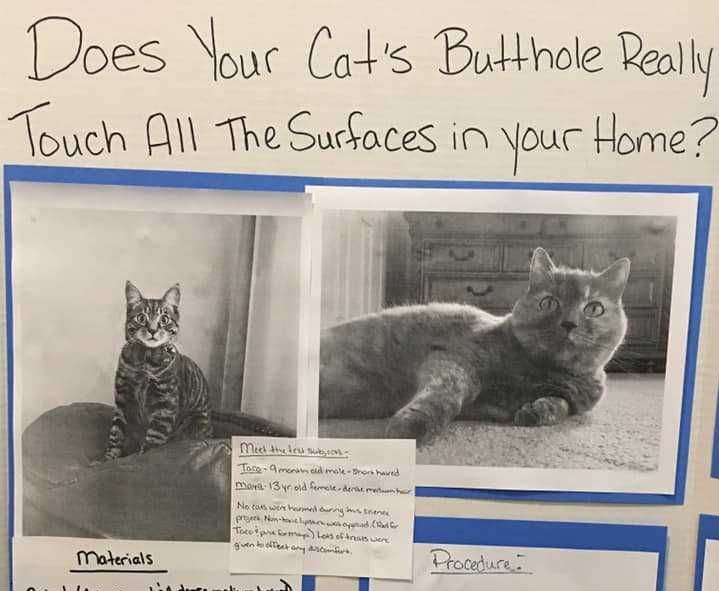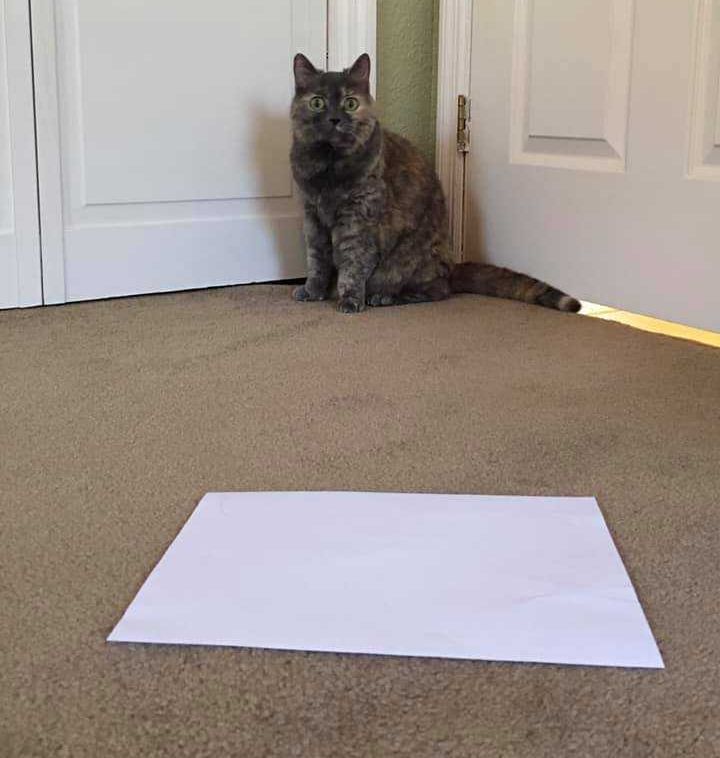6th grader's science fair project answers age-old question: 'Do cat buttholes touch everything?'
You know you've been wondering.
Cat owners are a special breed of people. Sometimes, in dealing with feline friends, they have unique questions that even Google doesn't always have the answer to. This is probably the sole reason cat forums exist, but one kid who needed a 6th grade science project decided to skip the cat forums for answers and instead use the scientific method. Kaeden Henry, a sixth grader living in Florida, bravely pondered a question few (if any one) has been brave enough to ask: do cat buttholes touch every surface they sit on?
Since cats do whatever the heck they want, training them not to jump on kitchen counters is a feat even Hercules struggles to complete. These fierce felines don't care if you're cooking dinner or trying to get comfy in bed. If they want to sit somewhere, they're going to do it. The thought of cat butts on that expensive Serta pillow designed to feel like you're sleeping on a cloud can gross people out, but thanks to Kaeden, you no longer have to wonder if the butthole itself is also making contact.

The curious sixth grader is homeschooled and well-versed in the scientific method thanks to her mother's PhD in animal behavior with a concentration in feline behavior. And, since they own cats, the science experiment was pretty straightforward (and directly impactful).
To complete the experiment, Henry and his mom, Kerry Hyde, bought non-toxic lipstick and applied it to each of their cat's anuses. Then, the cats were given commands. (Commands... hilarious, right?)

"Non-toxic lipstick was applied to their bum-bums, they were then given a series of commands (sit, wait, lie down, and jump up. Side note: Both cats have been trained since kittenhood with a variety of commands, they also know how to high-five, spin around, and speak.), they were compensated with lots of praise, pets, and their favorite treats, and the lipstick was removed with a baby wipe once we collected our data in just under 10 minutes," Hyde wrote in a Facebook post.
The results? Turns out that, no, cat buttholes do not touch every surface cats sit on.
Now, let's all take a collective sigh of relief while we go over the details. Kaeden's experiment covered long-haired, short-haired, and medium-haired cats (if your cat is hairless, you better stock up on Clorox wipes just in case).
"His results and general findings: Long and medium haired cat’s buttholes made NO contact with soft or hard surfaces at all. Short haired cats made NO contact on hard surfaces. But we did see evidence of a slight smear on the soft bedding surface. Conclusion, if you have a short haired cat and they may be lying on a pile of laundry, an unmade bed, or other soft uneven surface, then their butthole MAY touch those surfaces!" Hyde shares.
Now every curious cat owner can rest easy knowing that as long as their cat has hair, their bare bottom balloon knot is not touching the majority of surfaces in their home.

The amusing experiment caught the Internet's attention. People laughed and commented, with one person writing, "This is probably the most useful information I’ve learned from a science fair project."
"Good to know!...I can now eat my sandwich left on the counter with confidence!" another writes.

"A+++!!! Whew!! I am very grateful for your sciencing on this subject. My fears from walking in on my cat sitting on my laptop keyboard and subsequently being grossed out and cleaning furiously in a hyper-ocd manner have been somewhat allayed and now maybe I won’t have to use QUIIITE so many wipes." someone chimes in.
"Finally.. Someone answers the important questions!!"
The best part of the story? Kaeden's mom has a Ph.D. in animal behavior, specializing in feline behavior, and even she learned something new. The power of science!
This article originally appeared in April. It has been updated.
- Comedian shares what cats would say if they could talk and it's hilariously accurate ›
- Two beloved cats had to be rehomed, and their full-circle story is bringing people to tears ›
- Epic coworker spat over two workplace cats, Jean and Jorts, just keeps getting funnier ›
- People are losing it over 'first-time mom' cats and their questionable maternal instincts ›
- 8th grader's award-winning experiment finally reveals if dog's mouths are cleaner than ours - Upworthy ›
- Kid shares unhinged Rice Krispies Treat science experiment - Upworthy ›
